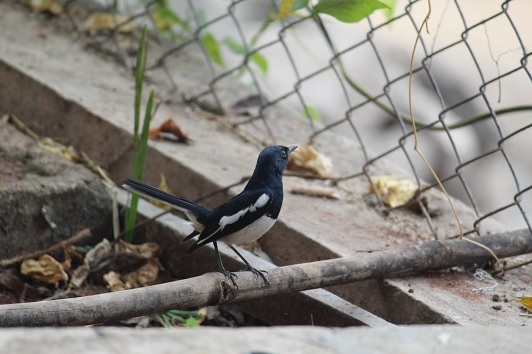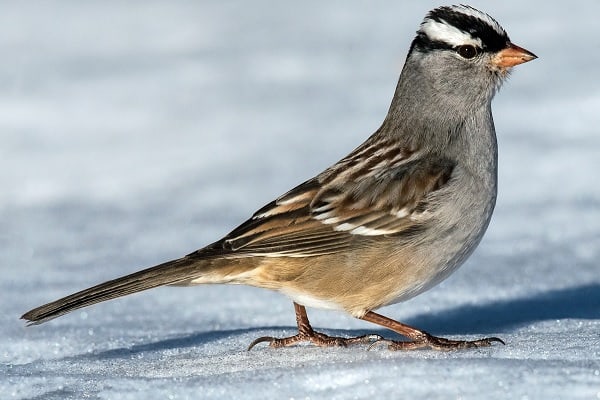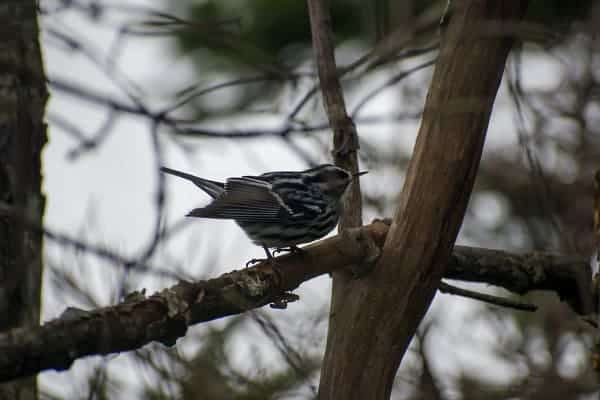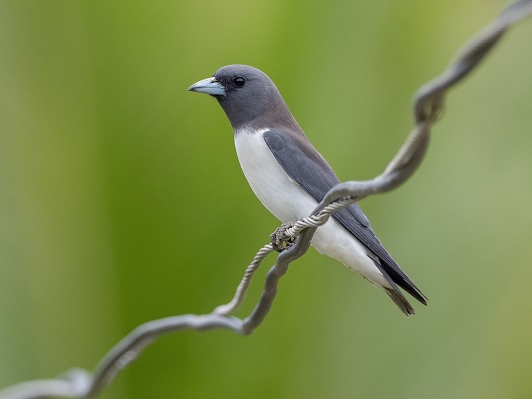Small black bird with white belly are captivating creatures that I have researched for this blog post. You will learn about 14 fascinating species with unique characteristics and quirks. As we explore their worlds, you will appreciate their beauty, their habitats, and their role in our ecosystems.
Types of Small Black Bird With White Belly
1. Common Black-Capped Chickadee

Have you ever seen a small black bird with a white belly and a cheerful song? Chances are, you have encountered a common black-capped chickadee. These birds are named after their distinctive black cap and their “chick-a-dee” call. They are one of the most common and beloved birds in North America, and for good reasons. Here are some of the amazing features and facts about these charming creatures.
A Striking Appearance
The common black-capped chickadee has a bold and beautiful plumage that makes it easy to identify. It has a black cap on its head, a black bib on its throat, and white cheeks that contrast with its dark feathers. Its underbelly is pure white, while its back, wings, and tail are a soft gray. It also has a short and stout bill that is perfect for cracking seeds and nuts.
A Friendly and Curious Behavior
The common black-capped chickadee is not shy. It is curious and friendly, often approaching humans with interest. It may even perch on your hand if you offer it some food. This is also social and cheerful, living in flocks of up to a dozen birds. Also, It communicates with its mates using a variety of calls and songs, such as the “chick-a-dee” and the “fee-bee”. It is also smart and adaptable, able to survive in different habitats and climates.
Remarkable Survival Skill
The common black-capped chickadee has a unique and impressive ability to lower its body temperature during the night. This helps it conserve energy and stay warm in cold weather. It can drop its temperature by 10-15 degrees Celsius, which is equivalent to 18-27 degrees Fahrenheit. This is a rare trait among birds, and it shows how resilient these birds are.
Memory Powerhouse
The common black-capped chickadee is also a memory powerhouse. It can remember the locations of hundreds of food caches that it hides throughout its territory. It can also recall the quality and quantity of each cache, and retrieve them when needed. This is a vital skill for surviving the winter when food is scarce and competition is high. It also shows how intelligent these birds are, as they can use spatial and temporal cues to find their hidden treasures.
Familiar and Lovable Bird
The common black-capped chickadee is a familiar and lovable bird that many people enjoy watching and feeding. It is one of the most popular birds in North America, and it can be found in a variety of habitats, from forests to backyards. Besides, It is one of the easiest birds to attract and identify, as it readily visits bird feeders and has a distinctive appearance and sound. It is a bird that brings joy and wonder to many people, and it deserves our appreciation and respect.
Related Article: Spiritual Meanings of Blackbirds
2. European Pied Flycatcher

Appearance and Range
- Black and White Plumage: With striking black and white plumage, the European Pied Flycatcher is a summer visitor to Europe.
- Summer Visitor to Europe: These birds migrate to Europe during summer, adding to the region’s avian diversity.
- Nesting Behavior: They are known for their fascinating nesting behaviors, often choosing tree cavities as their nesting sites.
Hunting and Diet
- Expert Insect Catcher: Flycatchers are skilled aerial hunters, capturing insects mid-air with incredible precision.
- Hunting Methods and Nesting Locations: They perch on branches, waiting for insects to fly by before darting out to catch them in a flurry of feathers.
- Conservation Status: These delightful birds face challenges in breeding grounds, making conservation efforts crucial.
Conservation Efforts and Success Stories
- Challenges Faced by European Pied Flycatchers: Habitat loss and climate change threaten their breeding sites, highlighting the need for conservation action.
- Conservation Efforts and Success Stories: Several organizations and birdwatching communities are actively working to protect these iconic birds.
Visit: Hawk vs. Eagle
3. White-Breasted Nuthatch

Physical Attributes
- Blue-Gray Back and Distinct Black Cap: The White-Breasted Nuthatch is easy to spot with its blue-gray back and prominent black cap.
- White Underbelly and Rusty Flanks: Their white underbelly and rusty flanks add to their unique appearance.
- Specialized Feet for Clinging: Their strong feet are adapted for clinging to tree trunks and branches.
Lifestyle and Habits
- Tree-Climbing Experts: Nuthatches are renowned for their acrobatic tree-climbing skills, often seen walking headfirst down tree trunks.
- Unique Foraging Techniques: They forage for insects and seeds by wedging them into tree crevices and using their beaks to crack them open.
- Territorial Calls and Communication: Nuthatches communicate through distinctive calls crucial in territory defense.
Endearing Behaviors
- Food Caching Antics: Nuthatches are known for storing food in tree bark crevices, a behavior that’s both adorable and practical.
- Courting and Breeding Displays: Males perform intricate flight displays to woo potential mates during breeding.
Examples:
- Nuthatches are renowned for their acrobatic tree-climbing skills.
- They forage for insects and seeds by wedging them into tree crevices.
- Nuthatches are known for storing food in tree bark crevices.
4. Oriental Magpie-Robin

Appearance
- Black and White Contrast: Magpie robins boast a striking black and white contrast in their plumage, making them stand out.
- Popularity in Asia: These birds are beloved across Asia for their melodious songs and captivating mimicry.
Habitat and Distribution
- Wide-Ranging in Asia: They have a wide distribution across Asian countries, from India to Southeast Asia.
- Urban Adaptability: Magpie-robins thrive in urban environments, adding a touch of nature to bustling cities.
Nesting and Mating Rituals
- Role in Folklore and Culture: These birds hold significant symbolism in various Asian cultures, often associated with luck and prosperity.
- Influence on Literature and Art: Magpie-robins have inspired countless poets, writers, and artists.
You May Want to Read: How Do Birds Mate?
5. The Black-Throated Sparrow

Distinctive Features
- Bold Black Throat Patch: The Black-Throated Sparrow is easily recognized by its bold black throat patch.
- Desert Dwelling: These resilient birds are well-adapted to arid desert landscapes.
Song and Call
- Desert Adaptation: Their songs and calls are adapted to the unique acoustics of the desert, allowing them to communicate effectively.
- Survival Strategies in Arid Landscapes: They’ve developed remarkable strategies to thrive in the challenging desert environment.
Conservation Concerns
- Impact of Climate Change: Climate change poses a significant threat to desert ecosystems, affecting the Black-Throated Sparrow and other desert species.
- Protection Efforts in Desert Ecosystems: Conservation initiatives aim to safeguard these fragile habitats.
6. Pied Wagtail

Plumage and Physical Traits
- Playful Black-and-White Markings: Pied Wagtails sport playful black-and-white plumage, resembling dapper little tuxedos.
- Wagging Tail Display: Their distinctive tail-wagging display adds a touch of charm to their demeanor.
Ecological Niche
- Preference for Watery Habitats: You’ll often find Pied Wagtails near water bodies, where they feed on insects.
- Feeding on Insects: They’re skilled insect hunters, often seen darting and catching insects mid-flight.
Relationship with Humans
- Urban Adaptability: These adaptable birds have successfully carved out a niche in urban environments.
- Thriving in Cities: Pied Wagtails are common in parks, gardens, and even city centers.
Nesting Sites and Behaviors
- Challenges of Urban Life: Nesting in urban areas comes with its own set of challenges, but these birds have found innovative solutions.
Most Recommended: Small Birds With Red heads
7. White-Crowned Sparrow

Appearance and Markings
- Notable White Crown: The White-Crowned Sparrow’s distinctive white crown is a key feature that aids in identification.
- Geographic Variations: Different populations exhibit variations in their plumage.
Migratory Patterns
- Song and Communication: Their melodious songs vary across regions, and individual sparrows have their unique vocal dialects.
- Distinctive Melodies: The White-Crowned Sparrow’s songs are a delightful addition to the soundscape of their habitats.
Conservation Status
- Threats to Their Habitat: Habitat loss and degradation pose significant threats to these sparrows.
- Importance of Protected Areas: The role of protected areas in preserving their habitats and populations.
Citizen Science Contributions
- Importance of Citizen Science: Enthusiastic birdwatchers contribute valuable data to scientific research on these sparrows.
- Engaging in Conservation: You can get involved in citizen science projects to help monitor and protect these birds.
8. Collared Flycatcher

Appearance
- Black Collar and Cap: Collared Flycatchers are known for their distinctive black collar and cap.
- Distribution in Europe: They are primarily found in various European countries.
Migratory Behavior
- Breeding and Nesting: These birds embark on long migrations to their breeding grounds, showcasing their remarkable navigation skills.
- Attracting Mates: Males use their striking plumage to attract potential mates during the breeding season.
9. Black-and-White Warbler

Importance in Ecosystems
The Black-and-White Warbler is also a small black bird with white belly, but its presence significantly impacts the ecosystems it inhabits.
- Controlling Insect Populations: These warblers are voracious insect eaters, and their foraging habits help control insect populations in their native Eastern North American forests. This ecological role benefits the warblers and the entire forest ecosystem.
- Ecological Roles in Their Range: The singers’ constant movement through the forest canopy has other ecological benefits. They help disperse seeds and can act as indicators of the overall health of the forest.
10. The Black-Headed Gull

Human Interactions
Black-headed gulls often share their habitats with humans, leading to intriguing interactions and sometimes challenges.
- Coexistence in Urban Areas: In many European and Asian cities, these gulls have adapted to urban life, scavenging for food near water bodies and even in bustling marketplaces. Their presence adds a touch of wildness to urban landscapes.
- Conservation Efforts for Urban Gull Populations: Urban gull populations face unique conservation challenges, including habitat loss and human conflicts. Conservation efforts aim to strike a balance between human needs and gull conservation.
11. White-Winged Black Tern

Conservation Challenges
The White-Winged Black Tern, with its striking appearance and wetland habitat, faces its share of conservation challenges.
- Wetland Degradation: Wetland ecosystems, crucial for these terns’ survival, are under threat from habitat degradation and pollution. Preserving these habitats is essential for their long-term well-being.
- Protection Measures for Migratory Routes: These terns embark on long migrations, making them vulnerable to various threats along their routes. International cooperation is necessary to protect their migratory corridors.
12. Black-Collared Starling

Cultural Significance
Black-Collared Starlings have left an indelible mark on the cultures and traditions of the regions they inhabit.
- Folklore and Superstitions: In some Asian cultures, these starlings are believed to bring good luck and are associated with positive omens. Their distinctive calls have even influenced traditional beliefs.
- Impact on Local Ecosystems: Beyond their cultural significance, these starlings play a role in local ecosystems by dispersing seeds and controlling insect populations. Their presence is a testament to the intricate web of life.
As we explore the cultural ties and ecological contributions of the Black-Collared Starling, we appreciate the multi-faceted roles these birds play in the tapestry of existence.
If you are a bird lover then must visit our platform, BirdingSky.org
13. White-breasted wood swallow black bird with white belly

Conservation Efforts
Preserving the habitats of the White-Breasted Woodswallow is paramount to ensuring their continued existence.
- Habitat Preservation: Conservation initiatives focus on safeguarding the woodswallows’ natural habitats, often including woodlands, savannas, and coastal areas. Protected reserves and national parks are vital for their survival.
- Community Engagement in Conservation: Local communities are crucial in woodswallow conservation efforts. Education and community involvement help raise awareness and promote sustainable coexistence.
14. Black-collared Apalis Bird with White Belly

Conservation Challenges
Despite their adaptability, Black-Collared Apalis face significant conservation challenges.
- Habitat Destruction: The relentless destruction of forests and loss of canopy cover threaten their natural habitat. Addressing deforestation is a critical step in preserving these birds.
- Conservation Initiatives in Africa: Conservation organizations actively aim to protect the Black-Collared Apalis. These initiatives involve habitat restoration, research, and community partnerships.
Related Article: Common Hawks In Georgia
People Also Ask
Q1: Are all small black birds with white bellies black and white?
While many share this color pattern, variations exist, and some may have additional colors in their plumage.
Q2: What is the significance of the black collar in these birds?
The black collar often serves as a distinctive feature, aiding in identification and sometimes playing a role in courtship displays.
Q3: Are these birds found only in specific regions?
No, these species can be found in various parts of the world, including North America, Europe, Asia, and Australia.
Q4: What can I do to help conserve these birds?
You can support conservation organizations, participate in citizen science projects, and promote awareness of their importance in ecosystems.
Q5: Can I attract these birds to my backyard?
Suitable food, water, and nesting sites can attract some of these species to your garden, depending on your location.
Final Thoughts:
Small black birds with white bellies are nature’s remarkable creations, each species with unique charm and significance. Birdwatching allows us to appreciate their beauty and understand their importance in our ecosystems. As we delve into the worlds of these 15 fascinating species, we are reminded of the importance of conservation efforts. These birds rely on us to protect their habitats and ensure their survival for generations.
